
Layout, design and features …
On the outside, the metal casing has a simple black design with rounded edges on the sides. The case should contribute significantly to the overall weight, since class D amplifiers with prefabricated ICs are per se very compact and require fewer or smaller heat sinks compared to class A variants. Overall, the amplifier is an absolute lightweight.
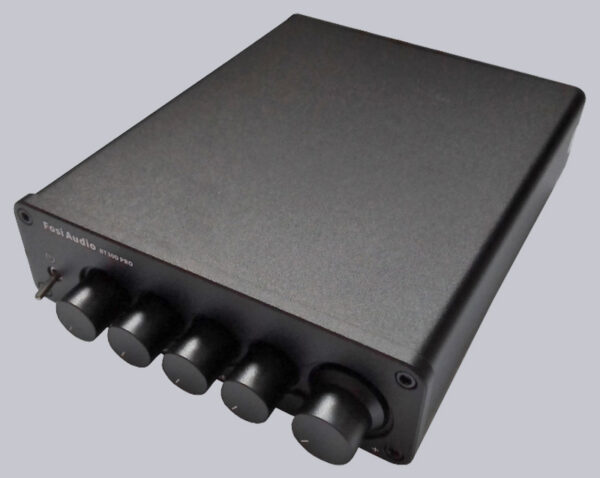
But the size of the Class D amplifier is also correspondingly small, as you can see here in a comparison to the Cambridge Soundworks DTT2500 Digital Desktop Theater 5.1 amplifier, which has been in the OCinside.de office for decades and simply didn’t want to be discarded.
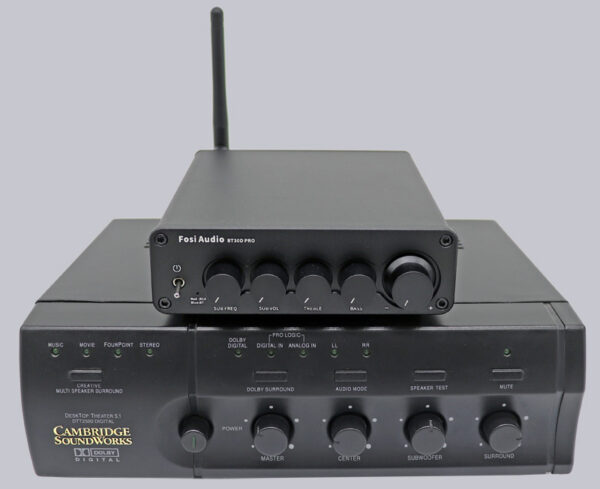
There is a small toggle switch at the front, which can be used to turn the amplifier on or off. In addition, there is a corresponding status display, which is indicated in a slightly different place on the previous product pictures. The new placement doesn’t disturb in any case and therefore can’t be criticized. The status LED indicates whether you have connected via Bluetooth or RCA. After turning on the amplifier, the status indicator lights up red and as soon as a Bluetooth connection is established, the LED lights up blue.
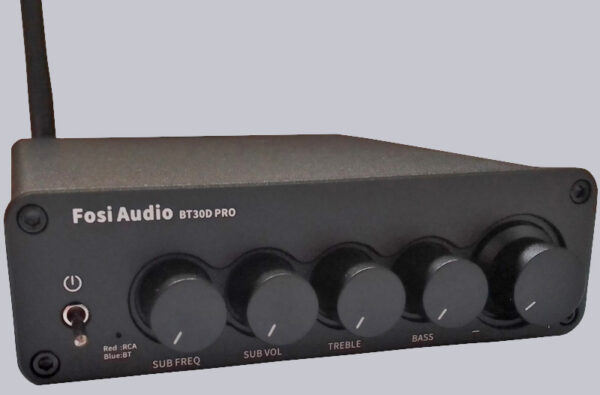
In the rear view, we see the RCA inputs from the PC side on the left, while a pre-out is located next to it on the right. If only the receiver part of the device is used and an external amplification is switched on, the latter is used. Even further to the right are the labeled speaker and subwoofer outputs in the typical color scheme as spring plugs or rather known as banana plugs.
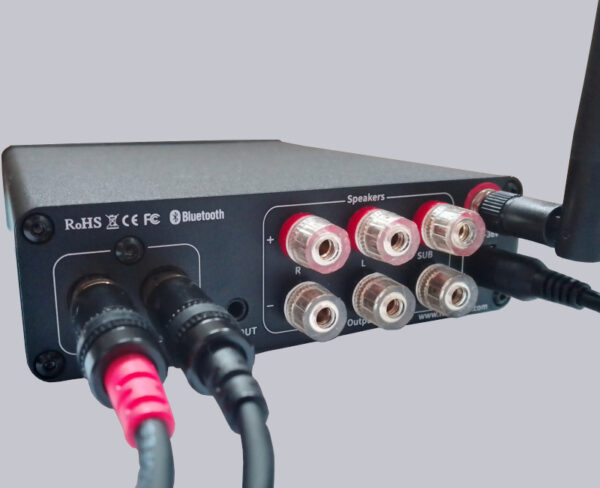
The DC19-36V power supply with the Bluetooth antenna that can be screwed on above it is also located on the far right edge.
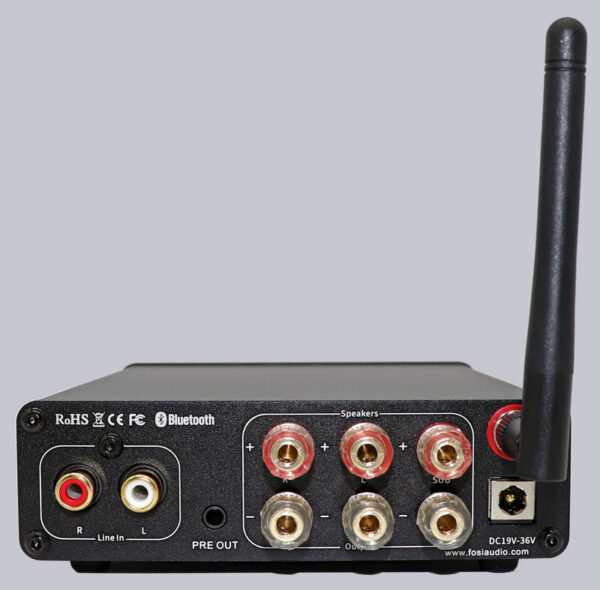
From the technical side, Fosi Audio advertises 60 megohm MOSFETs for low power dissipation. We assume that this addresses the drain-source resistance, since drain-source represents the operating current path in the MOSFET. Power losses due to fast switching itself are not yet quantifiable, since the switching frequency is the second factor. Basically, however, a low need for heat sinks is again indicated at this point, very much to the advantage of the costs and the total weight of approx. 680 grams. Even a less power-hungry headphone amplifier in class A can easily reach 1.5 kilograms. As you can see very well, the two amplifier ICs in the TSSOP package are cooled via the copper tracks as well as via aluminum heat sinks.
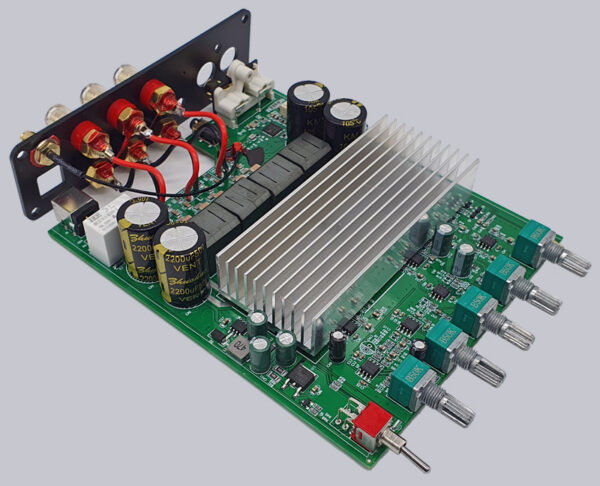
The wide traces on the top of the board to the amplifier IC were routed to the very close PVDD decoupling capacitors without through-hole plating, with the low-impedance X7R SMD ceramic capacitors still under the heat sink. In addition, a total of seven low-noise 2-channel audio operational amplifiers were also installed. And while we’re already taking a look at the board, let’s also take a look at the underside of the board. On the bottom side, the copper is applied as large as possible as GND and thus serves to improve the thermal performance as well as via the lower trace inductance for an improvement of the EMI reserve (electromagnetic interference). Overall, the layout is quite coherent and the workmanship is good.
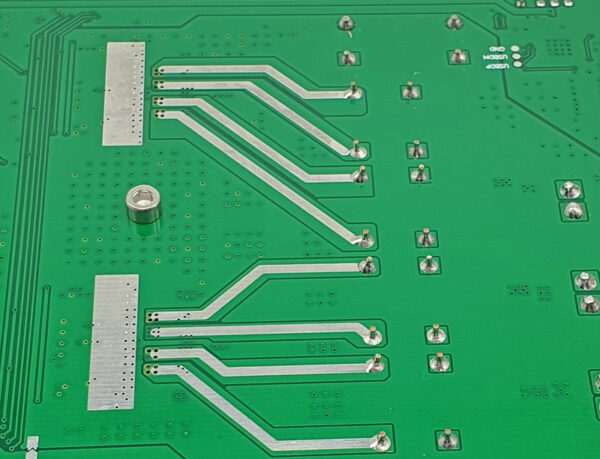
At its core, the BT30D Pro relies on the TPA3255 IC from Texas Instruments with 90% efficiency in the specification. In the data sheet, THD (Total Harmonic Distortion) is not listed as a naked figure in contrast to the entire device, but is put in the context of 1 watt and 4 ohms. This is a very low power value, while 4 ohms does justice to a low-impedance speaker. The THD percentage is said to be 0.006% for the IC, while the device as a whole is said to be at or below 0.03%. In contrast, (many) Class A amplifiers have significantly lower unwanted harmonic content and are thus considered better in terms of audio quality. Even if the percentage decimal places in THD sometimes suggest small absolute differences, their mathematical factor is enormous. Texas Instruments also shows that the optimal operating point is between 10 and 100 watts in terms of THD. Many 2.1 systems are in this power range anyway. Among others, we use a Logitech Z33, which is specified with a maximum of 80 watts.
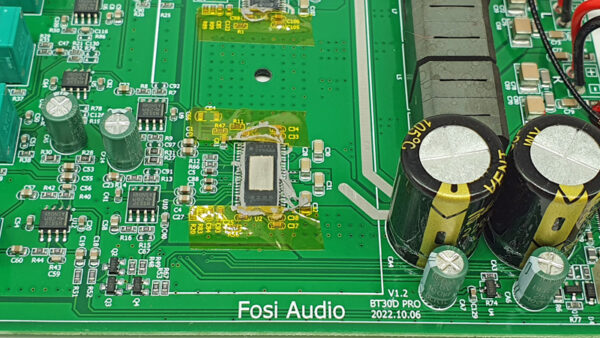
As a mini-excursion, the principle function of the class D amplifiers should be pointed out. Here, the audio input signal is compared with a generated triangular signal by a comparator. Depending on when the audio signal falls below and exceeds the level of the comparison value, a square wave pulse is staked out in time. On average, the level still corresponds to the audio signal in terms of value. The following transistor circuit increases the amplitude of these pulses, whereby their steep edges must be finally smoothed by a filter circuit. A certain dead time must also be tolerated so that not all transistors do not switch through at the same time. The successful amplification of the audio signal requires to supply energy externally. After all, a MOSFET cannot generate this on its own, but can only be controlled in terms of the portion of energy per unit time, and this with minimal energy supplied via the gate. With a predefined pulse width, the only remaining option is to increase the amplitude via the energy supply.
For all the theory, a poorly designed class D amplifier can turn out inefficient and an ill-conceived class A amplifier can deliver miserable audio quality. After all, the Texas Instruments IC is also wired externally. Accordingly, all theory is of no use in the end and we come to practical testing.
Fosi Audio BT30D Pro Speaker Amplifier Practical testing …

